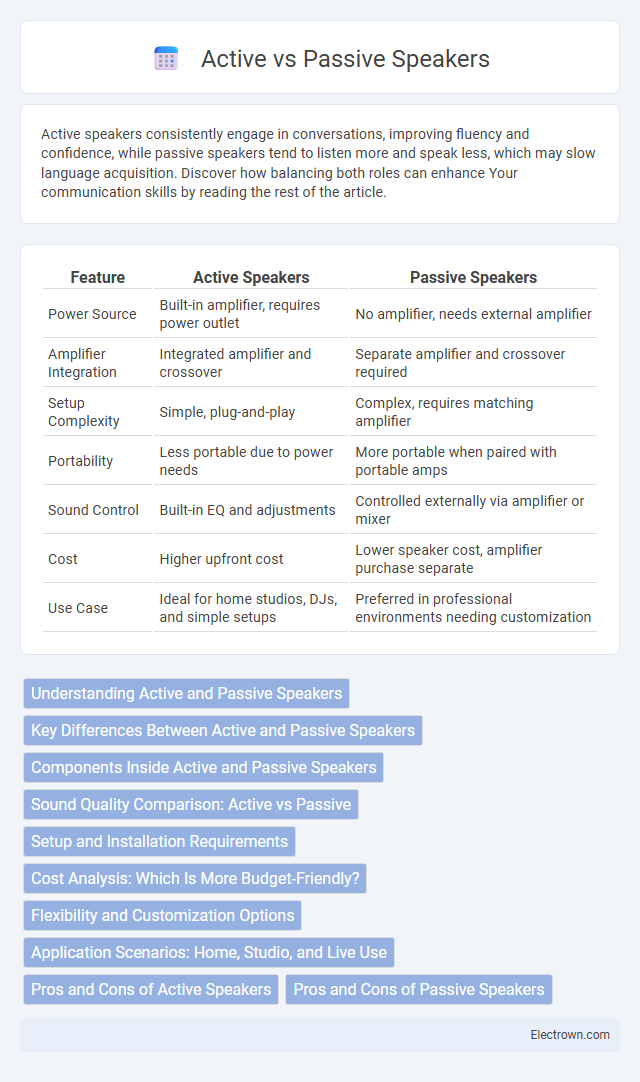Active speakers consistently engage in conversations, improving fluency and confidence, while passive speakers tend to listen more and speak less, which may slow language acquisition. Discover how balancing both roles can enhance Your communication skills by reading the rest of the article.
Table of Comparison
| Feature | Active Speakers | Passive Speakers |
|---|---|---|
| Power Source | Built-in amplifier, requires power outlet | No amplifier, needs external amplifier |
| Amplifier Integration | Integrated amplifier and crossover | Separate amplifier and crossover required |
| Setup Complexity | Simple, plug-and-play | Complex, requires matching amplifier |
| Portability | Less portable due to power needs | More portable when paired with portable amps |
| Sound Control | Built-in EQ and adjustments | Controlled externally via amplifier or mixer |
| Cost | Higher upfront cost | Lower speaker cost, amplifier purchase separate |
| Use Case | Ideal for home studios, DJs, and simple setups | Preferred in professional environments needing customization |
Understanding Active and Passive Speakers
Active speakers contain built-in amplifiers, allowing them to connect directly to audio sources without needing external amplification, which simplifies setup and enhances sound control. Passive speakers require an external amplifier or receiver to power them, giving you flexibility to upgrade components for tailored audio performance. Understanding these key distinctions helps you choose the best speaker type for your specific audio needs and preferences.
Key Differences Between Active and Passive Speakers
Active speakers have built-in amplifiers, allowing them to connect directly to audio sources, while passive speakers require external amplifiers to function. The integrated amplifier in active speakers provides optimized power matching and easier setup, resulting in improved sound clarity and efficiency. Your choice depends on convenience and system flexibility, with active speakers offering plug-and-play simplicity and passive speakers offering customizable amplification options.
Components Inside Active and Passive Speakers
Active speakers contain built-in amplifiers, crossovers, and power supplies integrated within the speaker enclosure, enabling direct connection to audio sources without external amplification. Passive speakers rely on external amplifiers for power and include only the speaker drivers and passive crossovers inside the cabinet, requiring careful matching to your amplifier for optimal performance. The internal components define how signal processing and power management are handled, affecting both setup simplicity and sound quality.
Sound Quality Comparison: Active vs Passive
Active speakers typically offer superior sound quality due to built-in amplifiers that are perfectly matched to the drivers, resulting in clearer audio and better frequency response. Passive speakers rely on external amplifiers, which can lead to signal loss or mismatches affecting overall sound performance. When choosing your audio setup, active speakers provide a more consistent and optimized sound experience without the need for additional equipment.
Setup and Installation Requirements
Active speakers contain built-in amplifiers, simplifying setup with fewer components and eliminating the need for external amplifiers, which reduces wiring complexity. Passive speakers require external amplifiers or receivers to power them, leading to more intricate installation and additional compatibility considerations between amplifier power ratings and speaker impedance. Proper setup of active speakers ensures optimized signal flow and power management, while passive speaker installation demands careful matching of amplifier specs and speaker wiring to prevent performance issues.
Cost Analysis: Which Is More Budget-Friendly?
Active speakers incorporate built-in amplifiers, reducing the need for external equipment and often lowering total costs, especially for beginners or small setups. Passive speakers require separate amplifiers, increasing overall expenses due to additional components and potential installation fees. Evaluating budget constraints and system complexity helps determine whether active speakers offer a more cost-effective solution compared to passive counterparts.
Flexibility and Customization Options
Active speakers feature built-in amplifiers and often include adjustable EQ settings and multiple input options, providing greater flexibility for various audio sources and environments. Passive speakers require external amplifiers, limiting customization but allowing users to tailor amplification and crossover settings independently. This distinction makes active speakers ideal for straightforward, customizable setups, while passive speakers offer expanded customization through separate component choices.
Application Scenarios: Home, Studio, and Live Use
Active speakers, equipped with built-in amplifiers and processors, excel in home and studio environments by offering simplified setup and consistent sound quality. Passive speakers require external amplification, making them favorable for live use where flexibility in power options and customization of sound output is essential. In professional live scenarios, active speakers provide portability and quick deployment, while passive systems often serve venues with permanent installed systems needing customizable amplifier configurations.
Pros and Cons of Active Speakers
Active speakers integrate built-in amplifiers, enhancing convenience and reducing the need for external equipment, which saves space and simplifies setup. They offer precise audio tuning through onboard equalizers and DSP, optimizing sound quality for various environments, though higher cost and potential heat generation are common drawbacks. Active speakers can deliver consistent performance and better protection mechanisms but may limit upgrade flexibility compared to passive speaker systems.
Pros and Cons of Passive Speakers
Passive speakers offer the advantage of flexibility by allowing users to select and upgrade amplifiers to match their preferences and system requirements, often resulting in cost savings compared to active speakers. They require external amplification, which can complicate setup and increase the need for additional components, potentially impacting portability and ease of use. Passive speakers are preferred in professional audio and custom installations due to their durability and scalability but may lack the built-in convenience and optimized performance of active speakers.
active vs passive speakers Infographic

 electrown.com
electrown.com